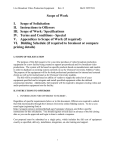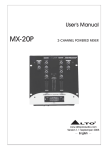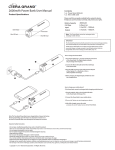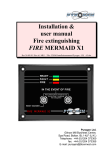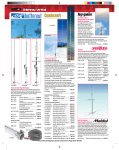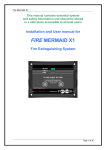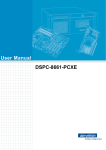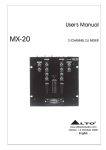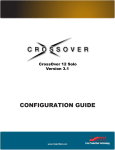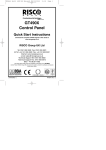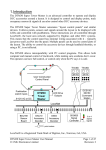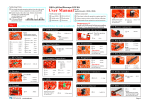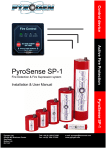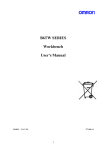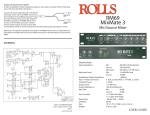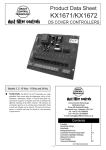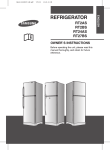Download 19” rack-mounted extinguishing and
Transcript
Quick Start Manual for PyroRack Quick Start User Manual & Log Book PyroRack 19” rack-mounted extinguishing and detection unit ©2001 Pyrogen ltd and its suppliers, all rights reserved doc number PYR- rev0/01 1 Quick Start Manual for PyroRack Important Note This manual contains essential system & safety information, before beginning any work involving the installation of PyroRack please read this manual. We would also advise that this manual be read in conjunction with the full design and detailed installation manual. In order to obtain a copy please contact your local distributor. When installation is complete please keep this manual in a safe place. We recommend that the installation and servicing of PyroRack should only be carried out by suitably qualified personnel who have been trained accordingly. This product is classed as “NOT USER SERVICEABLE” The use of non-recommended spares or parts or attempts at servicing other than described herein will invalidate conformity and any warranty. Copyright Notice This document and the information that it contains is the property of Pyrogen Limited. Any duplications or copies of this document should be done so only with the written permission of Pyrogen Limited © Copyright 2001 Pyrogen Ltd ©2001 Pyrogen ltd and its suppliers, all rights reserved doc number PYR- rev0/01 2 Quick Start Manual for PyroRack Revision History Amendment No Issue Details 0 1 Initial Issue of Manual Signed Date 1 2 3 4 5 6 7 8 9 10 ©2001 Pyrogen ltd and its suppliers, all rights reserved doc number PYR- rev0/01 3 Quick Start Manual for PyroRack Contents Chapter Description 1. Introduction 1.1 2. Page Introduction 5 Safety Information 2.1 2.2 3. General Safety – Control Section General Safety – Extinguishant Section 6 6,7 Quick Start / Installation 3.1 4. Ten Simple Steps to Protection 8,9 Indications & Functions 4.1 4.2 4.3 5. Indications Functions Fault Diagnostics 10 10 11,12 Technical Data 5.1 5.2 5.3 5.4 5.5 6. Internal Connection Details Internal Schematic Diagrams Internal Engineers Switch Settings External Connection Details External Schematic Diagrams 13 14,15,16,17 18 19,20 21 Servicing 6.1 6.2 6.3 6.4 7. User Checks Engineer Checks Recommended Service Spares Service Log 22 22 23 24 Certification 7.1 7.2 Declaration of Conformity Certificate of Installation & Commissioning ©2001 Pyrogen ltd and its suppliers, all rights reserved 25 26 doc number PYR- rev0/01 4 Quick Start Manual for PyroRack 1. Introduction 1.1 Introduction Representing the future in cabinet protection the 19” PyroRack is a self-contained automatic fire extinguishing system, which can be used in many industry sectors. Designed to be housed in 19” racking systems for the protection of delicate electronic equipment, the PyroRack is fully capable of detecting a fire using single or coincidence detection and responding by extinguishing the fire in less than 10 seconds of detection. Signals can also be sent to other equipment via VFCC or RS232 to inform of the units status and to key personnel for immediate investigation. By siting the 19” PyroRack at the top of each equipment rack the individual piece of equipment is being protected right at the heart of the potential risk, therefore more accurately pinpointing the fire at a very early stage and eliminating the need to discharge large costly amounts of fire suppressant. The extinguishant section can be accessed after a discharge and the extinguishant agent replaced as necessary. Additional remote detectors and extinguishant units may be wired into to rear of the unit to protect other areas or to provide additional coverage to the main cabinet. The units are available in different size depths, which have been developed to protect different sized cabinets. This product has been designed, manufactured and tested under the stringent requirements of: ISO 9002 This product has been tested and conforms to the following standards: EN55022, EN6100-3-2, EN50130-4,EN55022, EN55022, EN6100-3-2, EN61000-4-6, EN61000-4-3, EN61000-4-4, EN61000-4-2, EN61000-4-5 EN61000-4-11 The installation of this product should be carried out by a competent person and comply with the current editions of: The IEE Wiring Regulations The British Standard for Fire Detection and Alarm Systems for Buildings (Or equivalent national standards where applicable). ©2001 Pyrogen ltd and its suppliers, all rights reserved doc number PYR- rev0/01 5 Quick Start Manual for PyroRack 2. Safety Information 2.1 General Safety – Control Section 2.1.1 Ensure Extinguishant is ISOLATED before carrying out any works. 2.1.2 Before beginning any work on the control section please read this manual carefully. 2.2.3 When working with the control unit, prior to the removal of any cover plates please ensure the following steps are taken. • • • 240v ac Supply is disconnected. Extinguishant circuit is isolated. Anti Static Protection is used when handling PCBs. 2.2 General Safety – Extinguishant Section Pyrogen 2.2.1 Ensure Extinguishant is ISOLATED before carrying out any works. 2.2.2 Before beginning any work, involving handling of the MAG generator, please read this manual. 2.2.3 When working with the MAG generator it is forbidden to • Disassemble the MAG generator • Strike or impact the casing, or allow any other actions to occur which could result in deformation or mechanical damage to the case or its component parts. • Carry out any hot work or allow smoking near to the MAG generator or the thermal activation cord. 2.2.4 Should the generator be dropped check for visible signs of damage. Should there be any doubt as to the unit’s functionality contact your supplier. 2.2.5 Toxicity: Inadvertent exposure to Pyrogen aerosol should always be avoided. Toxicological information refers to an inadvertent exposure to the aerosol in the event of accidental discharge in a non-fire situation. The main ingredients of Pyrogen aerosol are solid potassium carbonates, nitrogen gas, carbon dioxide gas and water vapour. At normal extinguishing concentrations these products present little health hazard to personnel. However, small amounts of potentially hazardous by-products of the aerosol-generating combustion reaction, such as carbon monoxide and nitrogen oxides will be produced. Their actual concentrations depend on Pyrogen design factor used and type of enclosure under protection. Their toxicological characteristics depend upon the actual concentrations achieved and duration of exposure. 2.2.6 Re-entry: Following the use of Pyrogen, personnel should not enter the protected area until it has been thoroughly ventilated. Exposure to the fire by-products and extinguishant mixture should be avoided. Wearing a respirator or other available means of protection may be required should it be necessary to enter the area before it is fully ventilated. ©2001 Pyrogen ltd and its suppliers, all rights reserved doc number PYR- rev0/01 6 Quick Start Manual for PyroRack 2.2.7 Clean up: Following a system discharge the aerosol particles that have settled should be vacuumed, blown, brushed or, if appropriate, washed away. Protective gloves and goggles should be worn. A respirator or mask may be required. 2.2.8 Immediately after discharge the generators can be hot, therefore, protective gloves should be worn before handling generators up to 15 minutes after discharge. 2.2.9 Dangerous Goods Classification: Pyrogen is a Class 4.1 article in accordance with the United Nations Dangerous Goods Classification Code. CoSHH Statement: A by-product of Pyrogen aerosol-generating combustion reaction are fine potassium carbonate particles, small enough to be respirated by persons not wearing RPE. There are no known toxicological long-term effects of these soluble micron sized particles, and physiological effects of deep lung penetration are usually a concern for insoluble sub-micron particles as they can interfere with pulmonary functions. There are clear European guidelines controlling the exposure of persons to fine particles, irrespective of their nature. Further information is available in BS EN 481:1993 & BS EN 451:1993, and in CoSHH supportive documents EH40/98 & EH44 and MDHS 14/2. ©2001 Pyrogen ltd and its suppliers, all rights reserved doc number PYR- rev0/01 7 Quick Start Manual for PyroRack 3. Quick Start / Installation 3.1 Quick Start / Installation Step 1: Unpack your PyroRack: Check List : 1 x PyroRack unit, 1 x mains lead, 2 x keys, 3 x connection blocks, 2 x warning labels Step 2: Insert keys into panel and switch to “Isolate” position. Step 3: Remove cover from PyroRack by un-screwing small screws in top cover plate. Step 4a: Install 2 x 1.2 a/h SLAB in space provided by first removing battery cover plate. Step 4b: Connect batteries with leads provided. Red lead to red (+) battery terminal on battery No 1 Black lead to black (–) battery terminal on battery No 2 Use link to connect black (–) battery terminal on battery No 1 to red (+) terminal on battery No 2. Place batteries upside down onto plastic spacers provided ensuring that the terminals are spaced away from the metalwork. Step 4c: Replace battery cover plate ensuring it is fixed securely. Step 5: Replace main panel cover. Step 6: Securely position unit into the very top section of cabinet, which you are to protect. Step 7: Ensure that discharge area at the rear of the unit is free from obstruction for 300mm below the discharge deflector; also the discharge deflector should be close to the rear of the cabinet. To ensure uniform discharge it is important that there are no obstructions below the discharge area. Step 8a: Ensure key is inserted and switched to “Isolate” position. Step 8b: Plug main lead into rear of unit. Step 8c: Plug mains lead into a clean 230v ac Supply. When initially plugged in the unit will carry out self-check, which will initiate all lamps and sound buzzer. The buzzer will now sound intermittent with a long pause indicating fault condition. Step 8d: The panel should now be showing “Fault” indication “Isolated” indication “Power On” indication ©2001 Pyrogen ltd and its suppliers, all rights reserved doc number PYR- rev0/01 8 Quick Start Manual for PyroRack Step 8e: At this stage the batteries are still not in circuit and require link to be inserted into rear panel. Step 9: Ensure that fire indications are not lit and that Extinguishant released button is not lit. The keyswitch should be turned to the enable controls position and reset button pressed. The power on light should be the only indication lit and the buzzer should be silent. The keyswitch may now be returned to the “Normal” position. Step 10: Ensure that all doors are tightly shut on the cabinet and that all opening doors have warning stickers attached. Your cabinet is now protected by PyroRack Should you find any difficulties in the above guide please contact your PyroRack distributor, the above is only a guide and should be used by a fully trained engineer. You should ensure that a maintenance contract is taken with a suitable experienced company. ©2001 Pyrogen ltd and its suppliers, all rights reserved doc number PYR- rev0/01 9 Quick Start Manual for PyroRack 4. Indications & Functions 4.1 Indications Indication Description of indication Colour Power On Panel is in operational mode Green Fault Fault condition is apparent Amber Isolated Extinguishant circuit is isolated Amber Fire Fire condition has been detected Red Auxiliary/LP Alarm condition has been detected Amber Released Confirmation of extinguishant being released Red 4.2 Functions 4.2.1 The following functions will only operate when the keyswitch is in “ Enable Controls “ position. 4.2.2 Function Description of Function Silence When pressed will silence buzzer Reset When pressed a system reset is performed Extract Only operates after a fire condition, will reinstate the switched voltage out put to rear when pushed. The following functions will are for the keyswitch positions. Function Description of Function Isolate Isolate extinguishant circuit Enable Controls Enables the three push buttons – Silence, Reset, Extract Normal 4.2.3 System should be left in this position when unattended The “Extinguishant Release” emergency button will work in all situations with the exception of the system being in the isolated position. ©2001 Pyrogen ltd and its suppliers, all rights reserved doc number PYR- rev0/01 10 Quick Start Manual for PyroRack 4.2 Fault Diagnostics Fault Conditions : When a fault occurs on a part of the system the panel responds by activating the internal sounder (which will pulse intermittently) and illuminating the fault light (amber), the type of faults that would activate this are as follows: The internal sounder may be silenced however this will still give a reminder every 15 seconds, which cannot be silenced until the fault is rectified. The fault will automatically reset if the fault clears on its own, however this information is logged in the event log memory for engineering purposes. The following faults are numbered and if the system is reset and the fault remains on the panel the diagnostics will illuminate the auxiliary function / low pressure light the amount of times according to the fault number. 1 – Power Supply Fault Cause – fault signal is detected from the power supply (mains failure) Remedy – check all external fuses and that mains supply is present 2 – Battery Fault Cause – fault signal is detected from the power supply (battery failure) Remedy – check batteries are in circuit, check on rear external plate that battery link is in place (batt), check batteries for signs of malfunction – corrosion, overheating, shape distortion. 3 – Zone 1 Fault Cause – open or short circuit fault is detected from detection circuit no 1 Remedy – check detector 1 is situated on base correctly, if no other detectors are being used check that 6.8k end of line resistor is connected on rear external plate (Z1). If other external detectors are being used check that they are all in place and that all are situated on the bases correctly, also check that the end of line resistor is in place on the last detector. 4 – Zone 2 Fault Cause – open or short circuit fault is detected from detection circuit no 1 Remedy – check detector 2 is situated on base correctly, if no other detectors are being used check that 6.8k end of line resistor is connected on rear external plate (Z2). If other external detectors are being used check that they are all in place and that all are situated on the bases correctly, also check that the end of line resistor is in place on the last detector. 5 – Extinguishant Circuit / Actuator Circuit Fault Cause – open circuit has been detected on the extinguishant circuit ©2001 Pyrogen ltd and its suppliers, all rights reserved doc number PYR- rev0/01 11 Quick Start Manual for PyroRack Remedy – ensure that internal extinguishing actuators are in circuit, if fault persists they should be changed, external ensure that the extinguishing actuators (Mag Units) are in circuit. 6 – Hold Circuit Fault Cause – open or short circuit has been detected on hold circuit. Remedy – check end of line resistor is in circuit 6.8k on rear plate (hold), rear connection block is securely in place, any external wiring has end of line resistor fitted. 7 – Abort Circuit Fault Cause – open or short circuit has been detected on abort circuit. Remedy – check end of line resistor is in circuit 6.8k on rear plate (abort), rear connection block is securely in place, any external wiring has end of line resistor fitted. 8 – Pressure Monitor / Auxiliary Circuit Fault Cause – open or short circuit has been detected on pressure monitor circuit. Remedy – check end of line resistor is in circuit 6.8k on rear plate (LP), rear connection block is securely in place, any external wiring has end of line resistor fitted. 9 – Extinguishant Released Circuit Fault Cause – open or short circuit has been detected on released circuit. Remedy – check end of line resistor is in circuit 6.8k on rear plate (RLS’D), rear connection block is securely in place, any external wiring has end of line resistor fitted. 10 – 24v Output Fuse Cause – open circuit across fuse FH1 Remedy – check fuse and replace after determining fault which cause fuse to blow ©2001 Pyrogen ltd and its suppliers, all rights reserved doc number PYR- rev0/01 12 Quick Start Manual for PyroRack 5. Technical Data 5.1 Internal Connection Details Connections – Board No: PyroRack V2 – “ Main Processor Card “ All connections on this card are for factory use only. Connections – Board No: RedPSU V1 – “ Main Power Supply Card “ All connections on this card are for factory use only. Connections – Board No: Redrly V2 – “ Relay Card “ All connections on this card are for factory use only. Connections – Board No: Redcon 3 – “ Rear Internal Connection Card “ All connections on this card are for factory use only. ©2001 Pyrogen ltd and its suppliers, all rights reserved doc number PYR- rev0/01 13 Quick Start Manual for PyroRack 5.2 Internal Schematic Diagrams ©2001 Pyrogen ltd and its suppliers, all rights reserved doc number PYR- rev0/01 14 Quick Start Manual for PyroRack ©2001 Pyrogen ltd and its suppliers, all rights reserved doc number PYR- rev0/01 15 Quick Start Manual for PyroRack ©2001 Pyrogen ltd and its suppliers, all rights reserved doc number PYR- rev0/01 16 Quick Start Manual for PyroRack ©2001 Pyrogen ltd and its suppliers, all rights reserved doc number PYR- rev0/01 17 Quick Start Manual for PyroRack 5.3 Internal Engineers Switches Switch 1: Located on board no – PyroRack V2 main processor card. When switch 1 is in the up position (1) it will initiate the extinguishant release sequence upon single activation. When switch 1 is in the down position (2) it will instigate the panel to look for the second activation before initiating the extinguishant release sequence. Switch 2: Located on board no – PyroRack V2 main processor card. When switch 2 is in the off position the decision as to weather the extinguishing agent has been released is being made by the panel electrically, by determining that voltage has been sent to the actuation circuit. When switch two is in the on position the panel is looking for a input in to the RLS’D terminals at the rear connection board no Redrear V1, from a confirmation the agent has been released. Switch 3a, 3b & 3c: Located on board no – PyroRack V2 main processor card. These switches set the time of delay from the initiation of the extinguishant release sequence to actual release. The table below explains how this is achieved. Delay Time SW3A SW3B SW3C on off off 1 off on off 5 on on off 10 off off on 15 on off on 30 off on on 60 on on on 120 ©2001 Pyrogen ltd and its suppliers, all rights reserved doc number PYR- rev0/01 18 Quick Start Manual for PyroRack 5.4 External Connections Details Connections are detailed with the control panel in the fixed position from left to right, top to bottom. The 9 pin plug is for the RS232 / Palm Computer connection – NRZ Format, 1 start bit, 1 Stop Bit, 8 Data – Baud Rate 9600. All monitored inputs are monitored using a 6.8k-ohm E.O.L. resistor and firing is initiated using a 680ohm resistor. The male IES socket is for the input mains voltage 110/220 ac depending on voltage selected. The female IES socket is for a 10amp output to the fan unit or other equipment which needs to be shutdown, voltage as input voltage selected. Top Row Connections – Board No: Redrear V1 Connection Ref Connection Description + 48 +48 v dc Input to power unit in place of ← - 0 v dc Input to power unit in place of ← Abort Monitored Abort Signal ← Abort Monitored Abort Signal ← Hold Monitored Hold Signal ← Hold Monitored Hold Signal ← LP Monitored Low Pressure Input Signal ← LP Monitored Low Pressure Input Signal ← RLS`D Remote Actual Confirmation of Agent ← RLS`D Remote Actual Confirmation of Agent ← BATT Link to connect batteries in circuit BATT Link to connect batteries in circuit ©2001 Pyrogen ltd and its suppliers, all rights reserved Output Input → ← doc number PYR- rev0/01 19 Quick Start Manual for PyroRack Middle Row Connections – Board No: Redrear V1 Connection Ref Connection Description Output → Input ← Trig Remote Firing Circuit Input for Agent ← Trig Remote Firing Circuit Input for Agent ← Z2 + Zone Two Detection Circuit ← Z2 - Zone Two Detection Circuit ← Z1 + Zone One Detection Circuit ← Z1 - Zone One Detection Circuit ← Gas + Output to Remote Units → Gas - Output to Remote Units → 24 24v dc Output rated @ 500mA → 0v 0v dc Output rated @ 500mA → Bottom Row Connections – Board No: Redrear V1 Connection Ref Connection Description Output → NC Fault - Normally Closed Volt Free Contact → NO Fault - Normally Open Volt Free Contact → C Fault - Common Volt Free Contact → NC Fire 2 - Normally Closed Volt Free Contact → NO Fire 2 - Normally Open Volt Free Contact → C Fire 2 - Common Volt Free Contact → NC Fire 1 - Normally Closed Volt Free Contact → NO Fire 1 - Normally Open Volt Free Contact → C Fire 1 - Common Volt Free Contact → ©2001 Pyrogen ltd and its suppliers, all rights reserved Input ← doc number PYR- rev0/01 20 Quick Start Manual for PyroRack 5.4 External Schematic Diagram ©2001 Pyrogen ltd and its suppliers, all rights reserved doc number PYR- rev0/01 21 Quick Start Manual for PyroRack 6. Service 6.1 User Checks 6.1.1 Ensure Extinguishant is ISOLATED before carrying out any works. 6.1.2 The user should ensure that the system is in good working order at all times. The user should carry out on a monthly basis inspections of the system, these should include:- 6.1.3 The initiation of the reset button, which will perform a self-check of the control circuitry, all lights should indicate and buzzer sound once. 6.1.4 Looking out for obstructions to the discharge area, alteration / extensions of protected equipment. 6.1.5 Checking all openings, which should be securely closed is not left in the open position. 6.1.6 Area is free from dust or other foreign objects, which could cause unwanted false alarms. 6.2 Engineer Checks 6.2.1 Ensure Extinguishant is ISOLATED before carrying out any works. 6.2.2 The responsible person should ensure that every 3 months the following checks are carried out by a competent person:- 6.2.3 Entries in the Log Book are checked and any necessary action taken. 6.2.4 Batteries and their connections should be examined and tested to ensure they are in a good serviceable condition and not likely to fail before the next quarterly inspection. 6.2.5 The alarm functions of the control and indicating equipment by operation of a detector. 6.2.6 Visual inspection as in 6.1.4 6.2.7 Any defects should be recorded in the logbook and reported to the responsible person, and action taken to correct it. 6.2.8 On completion of the work, a certificate of testing should be given to the responsible person. ©2001 Pyrogen ltd and its suppliers, all rights reserved doc number PYR- rev0/01 22 Quick Start Manual for PyroRack 6.3 Recommended Service Spares We recommend that the following spare parts be kept in the event of the unit being damaged or the agent being released. Replacement Mag Units: Part No Description Mag 1 Mag 2 Mag 3 Mag 1 Aerosol Generator Mag 2 Aerosol Generator Mag 3 Aerosol Generator F/H1 F/H2 F/H3 Filter Housing for Mag 1 Filter Housing for Mag 2 Filter Housing for Mag 3 F/U Filter Unit – fits all housings. Replacement Circuit boards etc. PyroRack V2 Redcon3 Redrly V2 RedPSU V1 Processor card Rear card, also comes with Redrear card Relay Card Power Supply Card TZ1100 TZ1101 TZ1102 TZ1105 Optical Smoke Detector Ionisation Smoke Detector 60deg Combined Heat Detector 60deg Heat Fixed TZ1.2/12 1.2a/h Sealed Lead Acid Batteries For prices and availability please contact you local distributor. ©2001 Pyrogen ltd and its suppliers, all rights reserved doc number PYR- rev0/01 23 Quick Start Manual for PyroRack 6.4 Service Log Any changes, modifications, and repairs to the system or its components are to be noted on these pages. All recordings must contain date and signature. Date of Installation:…………………………. Installation Completed by:…………………………………………………… On Behalf of: (Company):…………………………………………………… Date Panel Ref No. ©2001 Pyrogen ltd and its suppliers, all rights reserved (P) Pass (F) Fail Action Signature doc number PYR- rev0/01 24 Quick Start Manual for PyroRack 7. Certification 7.1 Declaration of Conformity This appliance has been tested and conforms to the following standards: EMC testing: EN55022 EN6100-3-2 EN50130-4 Emission Standard – Information Technology Equipment Emission Standard – Harmonic Limits Immunity Standard – Fire, Intruder and Social Alarm Systems Along with the following tests: EN55022 EN55022 EN6100-3-2 EN61000-4-6 Conducted Emissions – AC Mains Input Port Radiated Emissions – Enclosure Port Emissions – Harmonic Limits Conducted RF Immunity – AC Mains/Signal Lines (AM+PM Modulation) EN61000-4-3 Radiated RF Immunity – Enclosure Port (AM+PM Modulation) EN61000-4-4 Fast Transient Bursts – AC Mains/Signal Lines EN61000-4-2 Electronic Discharge – Enclosure Port EN61000-4-5 Voltage Surges – AC Mains / Signal Lines EN61000-4-11 Voltage Dips – AC Mains Input Port Documentation is available at the companies address: Contact: Product literature and other downloads are available from www.pyrogen.com Pyrogen Ltd Gilnow Mill Business Centre Spa Road Bolton Lancashire BL1 4LF Tel: +44 1204 373300 Fax: +44 1204 373355 E: [email protected] W: www.pyrogen.com ©2001 Pyrogen ltd and its suppliers, all rights reserved doc number PYR- rev0/01 25 Quick Start Manual for PyroRack Certificate of Installation & Commissioning This certificate confirms the installation and commissioning of the fire alarm and suppression system (PyroRack) at: Protected Area Specific:……………………………………………………………… Premises / Address:…………………………………………………………………... ……………………………………………………………………………………….. ……………………………………………………………………………………….. The above system has been installed & commissioned in line with the manufacturers guidelines: Signed (Commissioning Engineer):………………………………..Date:……………. For and on behalf of:………………………………………………………………….. In case of emergency contact no:……………………………………………………... This manual is to situated at:…………………………………………………………. Official Use: Panel Serial No:………………………………………………………………………… Goods inspected and packed on:………………….Signature:………………………… ©2001 Pyrogen ltd and its suppliers, all rights reserved doc number PYR- rev0/01 26


























